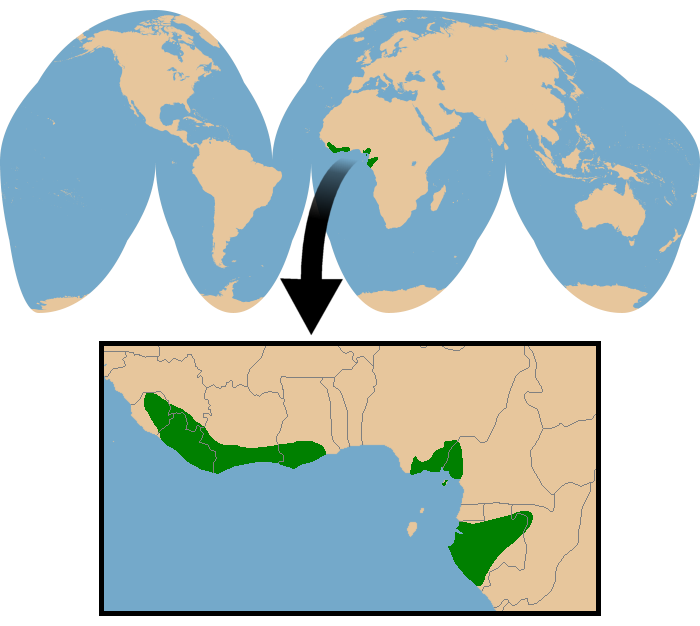Kingdom: |
Animalia Chordata Mammalia Artiodactyla Ruminantia Bovidae Cephalophinae Cephalophus |
Common name:
Scientific name:
Other names: |
Ogilby's duiker
Cephalophus ogilbyi
Brooke's duiker (brookei), white-legged duiker (crusalbum), céphalophe d'Ogilby, Ogilbyducker, Duiquero de Ogilby, Odabohene, N'Chumjbi
|
Physical Characteristics
- Head and body length:
85-115 cm
- Shoulder height: 55 cm
- Tail length: 12-16 cm
- Adult weight: 14-20 kg
- Shoulder height: 55 cm
This is a long-legged duiker with powerful hindquarters. The overall color is golden brown, although the belly is paler. A thin black stripe (1-6 cm wide) runs along the midline of the back, beginning at the shoulders and narrowing as it approaches the base of the tail. In Brooke's duiker (C. o. brookei), the stripe ends before reaching the tail, while in the two other subspecies (C. o. ogilbyi and C. o. crusalbum) the stripe continues onto the tail as a thin line. The tail is otherwise golden brown on top and white underneath, with a tuft of mixed white, black, and brown hairs at the tip. The legs are usually darker than the body, except in C. o. crusalbum, where the lower legs are bright white. The ochre face has a dark muzzle, white lower jaw, and distinct chestnut eyebrows. The forehead is bright rufous in color, topped with a sparse crest of longer hairs. Both sexes bear short, upward-curving horns that grow 8-12 cm long in males and 4-6 cm long in females.
- Similar species
In the field, "red duikers" are often difficult to tell apart, especially as they flee. Even photographs can be a challenge, depending on the angle. The relatively pale golden coloration and narrow dorsal stripe are the most distinctive features of Ogilby's duiker. The white legs of the white-legged duiker (subspecies C. o. crusalbum) are diagnostic.- The bay duiker (Cephalophus dorsalis) closely resembles Ogilby's duiker, but is nocturnal in habits, richer red in color, and has a wider dorsal stripe that extends up the neck to the back of the head.
- The white-bellied duiker (Cephalophus leucogaster) has a very wide dorsal stripe that often has a scalloped edge. The dorsal stripe of Peters's duiker (Cephalophus callipygus) widens towards the tail, spreading out over the hindquarters.
- The black-fronted duiker (Cephalophus nigrifrons) and Weyns's duiker (Cephalophus weynsi) do not possess a distinct dorsal stripe.
Reproduction and Development
Ecology and Behavior
Ogilby's duiker is one of the least-known duikers. It is diurnal in nature, showing very little activity in the hours of darkness, but is very secretive. Foraging typically occurs in the morning and late afternoon. Ogilby's duikers may follow monkeys moving through the forest canopy in order to feed on fruits, seeds, and flowers that fall to the ground. The midday is often spent resting. The few reported observations of wild Ogilby's duikers suggest that individuals maintain small home ranges (approximately 0.1 km2 in size). The same areas are returned to nightly for sleeping, and latrine spots are used. The principal vocalization is a "wheet" call.
- Family group:
Solitary or in pairs.
- Diet: Fruits and seeds, flowers, and leaves.
- Main Predators: Leopard and small cats; on Bioko, drills and pythons are the principal predators.
- Diet: Fruits and seeds, flowers, and leaves.
Habitat and Distribution

Conservation Status
- IUCN Red List:Least Concern (2008)
- CITES Listing: Appendix II (2012)
- Threats: Habitat loss and hunting for bushmeat.
- CITES Listing: Appendix II (2012)
The estimated total population is 35,000 animals. Brooke's duiker (C. o. brookei) is the rarest (5,000 animals), while Ogilby's duiker (C. o. ogilbyi - 12,000 animals) and the white-legged duiker (C. o. crusalbum - 18,000 animals) are more common.



